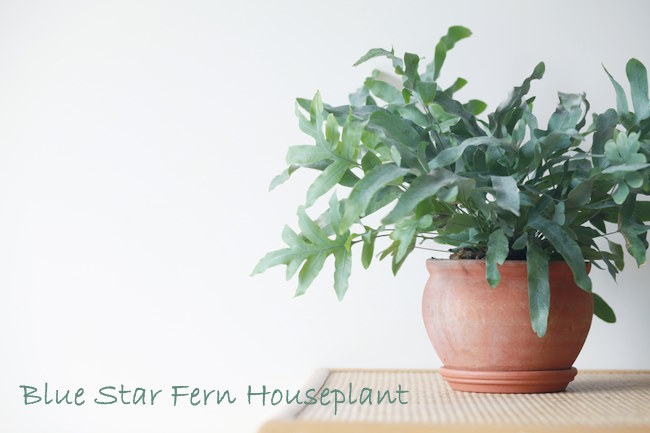Blue Star Fern Care Indoors
Blue Star Fern care is practically effortless. Set your houseplant in a bright location, water regularly, and you'll find it requires little upkeep. Want more? It's easy to propagate, too, if you want to grow your collection of these captivating indoor plants. And you do.
This tropical fern has blue-green fronds that are deeply lobed for eye-catching color, texture and form. Give your houseplant a pedestal to show it off. Or group it with other humidity-lovers on a multi-level plant stand.
Get to Know Your Blue Star Fern Plant
Known botanically as Phlebodium aureum, this South American native delivers drama without all the fuss.
Blue Star sports tough, blue-green fronds divided into a few large lobes. I love the look of its lush, thick foliage with a tinge of blue. I don't have to pick up after it, either. This elegant beauty doesn't shed like so many other ferns do.
How big does it get? Blue Star Fern will grow to 1 ft tall indoors, when confined to a container.
Blue Star Fern grows from fuzzy roots called rhizomes. These furry, golden rhizomes grow along the surface of the soil, giving this unusual fern a couple more common names: Bear's-Paw and Hare's-Foot Fern.
Is Phlebodium aureum poisonous? No. You can display this houseplant without worry -- it's non-toxic to people and pets.
 Image credit © Elena Baryshnikova
Image credit © Elena BaryshnikovaBlue Star Fern Problems, Solutions and Special Helps
Brown tips on fronds may be caused by dry soil or dry air. Aim to keep the potting mix lightly moist at all times. Raise the humidity around your houseplant with a cool-mist room humidifier.
Something bugging your fern? Watch for scale and for red spider mites. Isolate an infested plant to prevent pests from moving on to your other indoor plants. Don't use pesticides on ferns, which can badly damage leaves. Scale can be picked off with a fingernail or tweezers. Spider mites are not as easy to get rid of; set the plant in a sink or shower to rinse them off.
Tiny, orange spots on the undersides of the fronds are spores. That's how Blue Star Ferns produce new plants in their native South American habitat. You can ignore them. If you want to propagate your fern, it's much easier to divide the rhizomatous roots. (See "How to Propagate" below.)
Wondering when to repot? It's a good idea to repot your fern every couple years to give it a little more space. Spring is the best time to repot, when your houseplant is beginning its most vigorous time of growth.
What kind of pot have you got? This fern doesn't need a deep container, but use a wide pot to give space for the rhizomes to spread. And choose one with drainage holes to prevent root rot.
How to Propagate Your Plant
Large Blue Star Ferns can be propagated by division of the rhizomes. Spring is the best time to propagate houseplants because they are beginning their most vigorous time of growth.
What's a rhizome? It's a thick, bulblike root, typically with a long shape, with several nodes that can grow new stems or roots. Rhizomes make propagation easy because they already contain the necessary nutrients to produce a new plant.
Here are the steps to divide rhizomes:
- Remove your plant from its pot. If the roots are tangled, gently tease them apart with your fingers.
- Divide rhizomes by cutting through them with a clean, sharp knife or pruners, each with roots and stems attached.
- Pot each piece separately. Don't bury the rhizomes or they may rot; set them on top of the potting medium.
Why You Should Sterilize Houseplant Tools
It's a good idea to sterilize tools before pruning or propagating your houseplants. Although it takes a few extra minutes, don't skip this step. Cleaning them may prevent spreading mold, pests, and all kinds of microorganisms you can't even see, from plant to plant.
To sterilize knives, pruning shears or plant snips, they can be dipped in boiling water or simply wiped with rubbing alcohol.
Indoor Blue Star Fern Care
Light: Moderate to bright light. But keep Blue Star Fern out of direct sun, which will scorch its fronds. Indoor grow lights work well, too.
Water: Spring through fall, keep the soil moist, but not soggy. In winter, allow top 1 in (2.5 cm) of soil to dry out between waterings.
Humidity: Moderate to high (around 50-70% relative humidity). Hot, dry air will cause frond tips to turn brown. Boosting the humidity for your tropical fern is easier than you may think. Use a cool-mist room humidifier nearby or place pot on a tray of wet pebbles.
Temperature: Warm during the day (70-80°F/21-27°C). At night, keep it on the cool side (60-65°F/16-18°C).
Soil: Blue Star Fern grows best in a fast-draining mix of 1 part peat moss and 1 part potting soil.
Fertilizer: In spring and summer, feed once a month with a balanced liquid fertilizer, mixed at half the recommended strength. With Blue Star Fern care should be taken not to overdo it -- ferns aren't heavy feeders.


